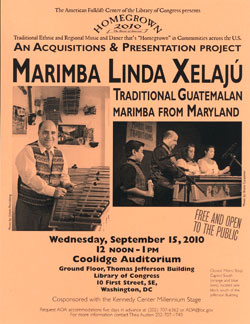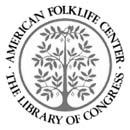| |
|||
|
The American Folklife Center at the Library of Congress presentsThe Homegrown 2010 Concert Series
|

|
Guatemalan marimba was born from a confluence of Mayan, African, and European instruments and musics: the xylophone shape came from the balafon-type instrument that African captives brought to Guatemala as early as the 16th century, the scales and melodies were primarily Spanish, and the buzzing resonators — or cajones — and the vibrant ornamentation of the instrument came from the Mayans. The distinctive buzzing of the cajones comes from a thin membrane (usually pig intestine) stretched across a small opening in the wooden resonator and adhered with beeswax. According to legend, the marimba was originally a country instrument. As people increasingly moved into cities from the Guatemalan countryside, the marimba became urbanized. The instrument today is made of "upper" and "lower" keys — the "lower" keys being the diatonic scale originally modified along the northern Guatemalan border with Mexico from the West African balafon; and the "upper" keys consisting of the notes added to encompass all of the chromatic scale. Large marimba orchestras — which can have up to eight people hitting wooden keys with rubber-tipped mallets — feature "twins," or two marimbas: a large marimba (Marimba Grande) and a small marimba (Tenor Marimba). Large marimbas can accommodate three or four musicians at once, each playing in a specified area and register.
Robert Giron is the founder and leader of Marimba Linda Xelajú, a small marimba orchestra (Marimba Grande, with drums and electric bass) from Silver Spring, Maryland. He was born in Quetzaltenango — known by its indigenous name as Xelajú — a majority Amerindian city of 300,000 in western Guatemala. Robert's uncle was a marimbista (someone who plays the marimba) and Robert learned by watching him play and by carrying his uncle's instrument to and from performances. "My uncle taught me from the time I was a little boy," says Robert. He was a teenager when his uncle first brought him onstage to perform. "I was like fifteen years old at that time. My uncle invited me to play with him and the people were dancing over there. I know some couple of songs already so I started playing with them and I look, and the people are dancing and everybody is looking at me for how to play! This is nice, it's fun . . . I remember at that time, everybody was making congratulations and saying, 'Oh I didn't know you play marimba' and that kind of stuff. It's an amazing moment that I have in my life."
After moving to Maryland in 1983, Robert had a marimba orchestra built for him by a master Guatemalan craftsman, or marimbero, named Nojobel Salazar. This is the instrument on which the Giron family learned to play. A devoted traditionalist about the musical aspects of marimba, Robert has bucked the tendency of marimbistas to teach only men. Performing alongside Robert are his daughters, Jennifer and Beverly, and his son, Robert Jr. "I got my dreams," says Robert. "I have my two daughters and my son playing with me. I have helped them to carry on and enjoy the music." Beverly Giron and her father were recognized in 2009-2010 by Maryland Traditions — the folklife program of the Maryland State Arts Council — with a prestigious Apprenticeship Award for Beverly to focus on learning core elements of traditional repertoire and harmony. Now 18, Beverly has been playing marimba since she was four. At a national marimba concert in Guatemala City in 2006, Beverly was the only woman to play. "I was scared," she says, "but afterwards all of the women came up to say how entertaining it was to see me up there with all of the men."
The marimba has been adopted as the national Instrument — and symbol of multicultural identity — of Guatemala. Today, marimba orchestras play an important role in the celebration of the Roman Catholic feast of Señor de Esquipulas — known as the "Black Christ” or "Cristo Negro" — another symbol of Guatemala's multicultural heritage both in Guatemala and in Latino communities in the United States.
The Giron family — and their group Marimba Linda Xelajú — perform at many events in the Guatemalan community of greater Washington, D.C., as well as at traditional Roman Catholic ceremonies for Señor de Esquipulas in Montgomery County and Baltimore City. They have also performed at the National Folk Festival, the Smithsonian Folklife Festival, the National Museum of the American Indian, and the Hispanic Heritage Festival in Washington, D.C.
Clifford R. Murphy, Ph.D.
Co-Director, Maryland Traditions
 The American Folklife Center was created by Congress in 1976 and placed at the Library of Congress to "preserve and present American Folklife" through programs of research, documentation, archival preservation, reference service, live performance, exhibition, public programs, and training. The Center includes the American Folklife Center Archive of folk culture, which was established in 1928 and is now one of the largest collections of ethnographic material from the United States and around the world. Please visit our web site.
The American Folklife Center was created by Congress in 1976 and placed at the Library of Congress to "preserve and present American Folklife" through programs of research, documentation, archival preservation, reference service, live performance, exhibition, public programs, and training. The Center includes the American Folklife Center Archive of folk culture, which was established in 1928 and is now one of the largest collections of ethnographic material from the United States and around the world. Please visit our web site.
| ||||
